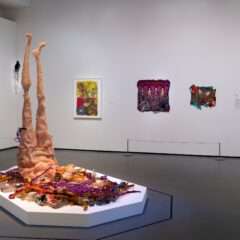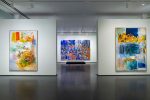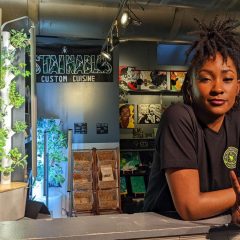Post by Andrea Kirsh
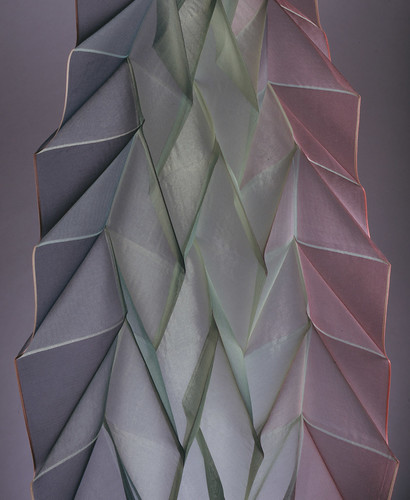
Origami Pleat. 1997. Designer: Reiko Sudo. Manufacturer: NUNO Corporation. Japanese. Purchased in Memory of Dena S. Katzenberg, Consultant Curator of Textiles, 1969-2000, with funds contributed by her Family and Friends. BMA 2002.50. © NUNO Corporation
I drove to Baltimore yesterday to see a student of mine, Meg Newberger, who’s interning in the conservation department of the Baltimore Museum of Art. In the course of the afternoon I saw all sorts of objects that were worth the trip and should be taken in by anyone going that way. They’re all from the BMA’s collection, in fact.
The first was a treasure of an exhibition, “NUNO: Japanese Tradition/Innovation in Cloth.” It is small: 15 lengths of fabric, four scarves and a blouse, all made by Nuno, a firm whose name means “fabric” in Japanese – as well as nine samples of textiles which visitors are invited to touch; these last make it especially worth the trip. In 1998 MoMA did a large and splendid exhibition, “Structure and Surface; Contemporary Japanese Textiles,” that included Nuno’s work, but the only way to appreciate any of the work tactile-y was to buy the catalogue which was bound in fabric by one of the exhibitors. I’ve long loved to touch these fabrics; Issey Miyake has used some of them, and I remember going into the Miyake shop in London and telling them I wasn’t buying (neither was anyone else in London – it was far from British taste), I only wanted to touch.
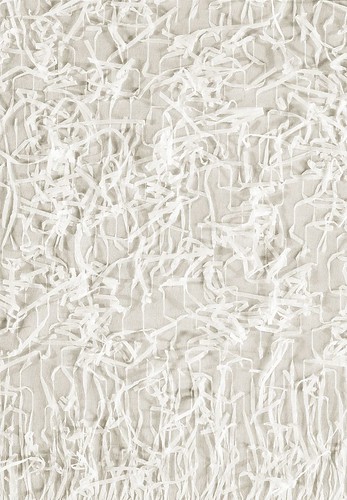
Patched Paper (Yaburegami). 1997 Designer: Reiko Sudo. Manufacturer: NUNO Corporation. Japanese. The Baltimore Museum of Art: Purchased in Memory of Dena S. Katzenberg, Consultant Curator of Textiles, 1969–2000, with funds contributed by her Family and Friends, BMA 2002.58. ©NUNO Corporation.
The samples for touching in Baltimore included some highly-unlikely materials: steel (the sort of fibers used to reinforce tires) woven with cotton, which was surprisingly soft, and another fabric of copper wire treated with a casein powder (a milk derivative) and acrylo-nitrite. My favorite, both for touching and looking at, is called “Patched Paper”; it has twisted bits of paper woven into polyester and resembles the pate of a balding man, with a few sparse hairs here and there.
The exhibition is arranged according to concepts behind the fabric designs. Most of them are words that have a range of meaning in Japanese, and it’s not clear how much irony is intended: Fuwa Fuwa (which translates as “soft,”“ spongy,” or alternately, “ frivolous”), Zawa Zawa (“clamorous,” “bustling”), Boro Boro (“tattered,” “frayed”) , Kira Kira (“glittering,”“dazzling,” “resplendent”) and Suke Suke ( “revealing,” “sheer,” or alternately,“flimsy”).
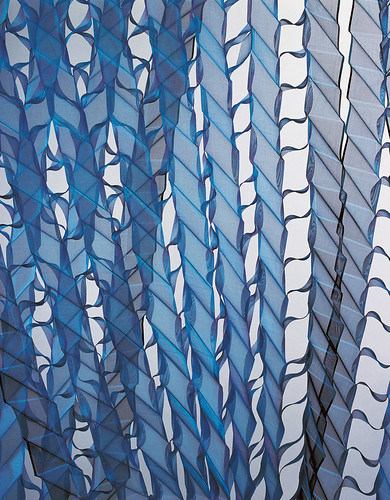
These may be conceptual fabrics but they are realized with extraordinary effort and ingenuity. Despite the high technology employed, all involve a degree of handwork, acknowledging the interest that Reiko Sudo, the founder, has in traditional Japanese hand-made textiles. They are also extraordinarily complex and beautiful. “Tanabata” is a sheer polyester both pleated and cut so that it has two different degrees of transparency. It’s design and name both reference the star festival, when wishes are written on strips of paper which are then tied around living bamboo.
I have to mention a couple of other gems I saw in Baltimore. Of course there’s Van Dyck’s early and Italianate “Renaldo and Armida,” as beautiful a painting as you’ll ever find. But there were two eye-catching objects in the decorative arts galleries that were new to me. One was a Steinway piano and bench from 1942, made of bleached mahogany in a modernist design possibly by Walter Dorwin Teague (who’s better known for designing airplanes and Texaco gas stations). He did design another Steinway, known as the “Peace Piano,” for the 1939 World’s Fair; it’s in the Smithsonian, but doesn’t compare to Baltimore’s as far as design.
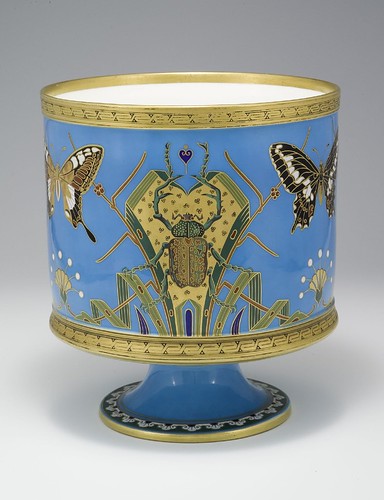
Jardiniere, c. 1870. Designer: Christopher Dresser. Manufacturer: Minton’s, England. The Baltimore Museum of Art, BMA 2006.101, 11 3/16 x 9 3/4 in. Diam. (28.4 x 24.8 cm.)
The other must-see is a porcelain jardiniere by Cristopher Dresser, decorated with scarab beetles and butterflies in what I’d call neo-Egyptian style, with a background of intense turquoise, the color of Egyptian faience. It’s a new purchase and they are rightly proud of it; apparently it’s the finest of only three known examples, which is why I’d never seen one like it, and I haunt decorative arts galleries pretty regularly.
A final comment about the BMA. In going through the contemporary galleries I couldn’t help but notice that, in contrast to Philadelphia, they were filled with work by women and artists of color: Helen Frankenthaler, Jo Baer, Yayoi Kusama, Lee Bontecou, Elizabeth Murray, Barbara Kruger, Lorna Simpson, Raphael Ferrer, Fred Wilson, David Hammons, Glen Ligon, Kerry James Marshall (this is a very partial list). I don’t know whether to credit this to a history of terrific women as curators of contemporary art in Baltimore (Brenda Richardson, Helen Molesworth, Darcie Alexander), but then the PMA had Anne D’Harnoncourt and Ann Temkin. Anyway, good for Baltimore!
I’m already planning a return visit in October when they host “Matisse: Painter as Sculptor.”
–Andrea Kirsh is an art historian based in Philadelphia. You can read her newest Philadelphia Introductions and other commentary at InLiquid.


